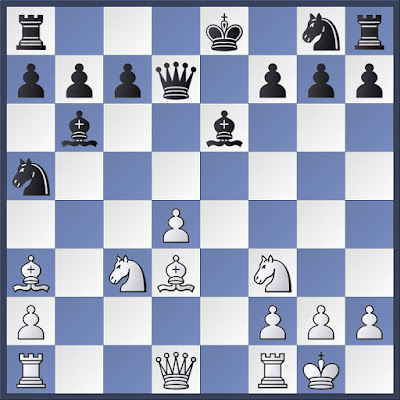Initial Impressions Towards a Review
My copy of Thomas Engqvist,
300 Most Important Chess Positions (2018) arrived last Friday less than an hour before a lesson with one of my students. I took the book with me. Inasmuch as the first lesson each month is devoted to the endgame, we worked through the first several endings (positions 151-155) in Engqvist's book after finishing the materials I had prepared for the session. We also looked at position 194, which caught my eye while flipping through the book because I had seen a similar problem last week.
After the lesson with my student, I read the front matter and looked at position number 1 in the book. This position is from Morphy -- Stanley, 1857, which I have been studying the past few days.
White to move
The correct move in this exercise is a matter of judgement. Many strong players have played the "wrong" move. Engqvist mentions Adolf Anderssen, but he could have noted that Morphy also played it several times in the two years after the game where he played the "correct" move. Morphy's "discovery" (14), however, has been the overwhelming choice of masters in this somewhat infrequent position (512 games in my database with a 63% score for White).
I can count on my fingers the number of books in my chess library that offer exercises where the correct answer is debatable. I think that is a testament to the value of this book. At first glance,
300 Most Important Chess Positions offers prospects for developing positional understanding.
Charles H. Stanley was one of four players to defeat Paul Morphy without odds in New York in 1857. Morphy, however, may have had the Black pieces more than his share in their games. Among the extant games between these two players, this game is the only one when Morphy had White.
Morphy,Paul -- Stanley,Charles Henry [C51]
New York, 1857
1.e4 e5 2.Nf3 Nc6 3.Bc4 Bc5 4.b4 Bxb4 5.c3 Ba5 6.d4 exd4
6...d6 is hot
7.0–0
7.Qb3 Qf6 8.0–0 Bb6 9.e5 is another possibility.
7...d6
Black could try 7...Nge7 8.Ng5 Ne5 9.Nxf7 Nxf7 10.Bxf7+ Kxf7 11.Qh5+ g6 12.Qxa5.
8.cxd4 Bb6
See diagram above.
9.Nc3
Engqvist offers the diagram. Under the diagram, he offers the moves leading to the position and Morphy's move. He highlights Morphy's importance historically in a few sentences, then mentions center control and time as White's temporary advantages in this position.
It's more important to develop pieces instead of making useless short-term attacking or defensive moves. In other words one should avoid unproductive one-move threats and instead concentrate on long-term gains.
Engqvist, 14
One-move threats are certainly how I cultivate losing streaks in online blitz at least once every week.
9.d5 White has scored well. This move has been played by De Labourdonnais, Anderssen, Morphy, and others with good results. Engqvist calls this move "superficial" (14).
I think that this first position has instructive value. Engqvist says that he uses it with his students, and I think it is worthy of addition to my stock of lessons as well. Although the alternative to his "correct" move is playable, the lesson is clear. I could have stopped here and moved on to the next position, but I found Morphy's game interesting.
9...Nf6
Was this move the decisive error?
9...Na5 seems best. Engqvist suggests that he lets his students play the game out from the position before 9.Nc3. Students can try Anderssen's approach, and they can avoid Stanley's reply.
10.e5
My database shows eight games with this move and eight wins for White. Stockfish 10 says White has a clear advantage.
10.Bg5 h6 11.Bxf6 Qxf6 12.e5 dxe5 13.Nxe5 Nxe5 14.dxe5 Qh4 was won by Black in 67 moves, De Labourdonnais,L -- McDonnell,A London 1834.
10...dxe5 11.Ba3 Bxd4
11...Nxd4 12.Nxe5 Be6 gives Black a slight edge, according to Hiarcs 12, but Stockfish 10 sees it as a decisive advantage for White.
12.Qb3
Black to move
This position is reminiscent of several of Greco's games.
12...Be6
And now +6 in favor of White.
After 12...Qd7 Fritz 11 considers the position equal, but Stockfish 10 has White with a winning advantage.
13.Bxe6 fxe6 14.Qxe6+ Ne7 15.Nxd4 exd4 16.Rfe1
Black to move
16...Nfg8
16...dxc3 17.Rad1 (17.Qxe7+? Qxe7 18.Rxe7+ Kd8 19.Rd1+ Kc8 White may have compensation for the pawns) 17...Nd7 (17...Nfd5 18.Rxd5) 18.Bxe7 Qc8 19.Bd6+ Kd8 20.Qe7#.
17.Nd5 Qd7 18.Bxe7
18.Qxd7+ Kxd7 19.Nxe7 Nxe7 20.Rxe7+ is given as better by Géza Maróczy in his book on Morphy. I do not have this book, but the annotations appear in David Levy and Kevin O'Connell,
Oxford Encyclopedia of Chess Games, vol. 1 1485-1866 (1981).
18...Qxe6 19.Rxe6 Kd7 20.Rae1 Re8 21.R6e4 c6
White to move
22.Rxd4 cxd5 23.Rxd5+ Kc6 24.Rd6+ Kc7 25.Rc1+ Kb8 26.Bh4! Nh6
White to move
27.Bg3 Ka8
27...Nf5 28.Rd8#
28.h3 Nf5 29.Rd7 g6 30.Rcc7 Nxg3 31.fxg3 Rb8
The rook ending is instructive.
White to move
32.Rxh7 Rxh7 33.Rxh7 a5 34.h4 Rg8
34...b5 35.h5 g5 (35...gxh5 36.Rxh5 a4 37.g4 b4 38.Ra5+ Kb7 39.Rxa4) 36.Rg7 b4 37.Rxg5 a4 38.Ra5+ Kb7 39.Rxa4
35.g4 b5 36.h5 a4 37.h6 b4 38.Rg7 Rh8 39.h7 b3
White to move
40.Rg8+ Kb7 41.Rxh8 b2 42.Rb8+ Kxb8 43.h8Q+ 1–0
Although Morphy had a clear advantage after Black's ninth move, his play through the whole game offers useful instruction in how to use the initiative to bring home the full point.




























